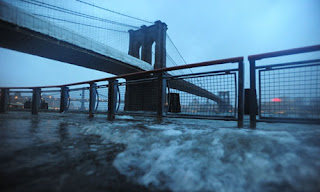It's hard not to love Twitter. It's useful to journalists trying to push out the most up-to-date information, and it gains special importance during disasters like Hurricane Sandy, which hit the East Coast last week. Although the real-time social media platform has its upsides, rumors spreading 140 characters at a time became a big problem during the storm.
Many were outraged by the account ComfortablySmug, which tweeted false information about Sandy. BuzzFeed learned the person behind the handle was Shashank Tripathi and deemed him "Hurricane Sandy's worst Twitter villain." Two of the biggest falsehoods Tripathi spread were about a citywide blackout in Manhattan and the floor of the New York Stock Exchange flooding. Some of his tweets were retweed more than 500 times.
Tripathi did send out a formal apology to New Yorkers and admitted to spreading the false information. But looking closer at what happened, it's worth asking: Are journalists somewhat to blame?
It wasn't just average Twitter users who retweeted Tripathi's claims. Many journalists and credible sources like the National Weather Service did, too. In fact, Tripathi's tweet about the New York Stock Exchange found its way to The Weather Channel and CNN. Heidi Moore of The Guardian noted that Tripathi's following on Twitter was relatively small and that had journalists not spread his words, the issue would have been resolved much quicker. Moore also pointed out the first responses to his false tweet from non-journalists were skeptical, calling the account's manager a liar.
Of course, journalists also successfully verified storm information circulating online. The Atlantic and a Tumblr blog called "Is Twitter Wrong?", for example, helped check photo authenticity. Poynter called this latter effort "central to debunking" breaking news during the hurricane.
Photo courtesy of The Guardian
Photo courtesy of The Guardian


No comments:
Post a Comment